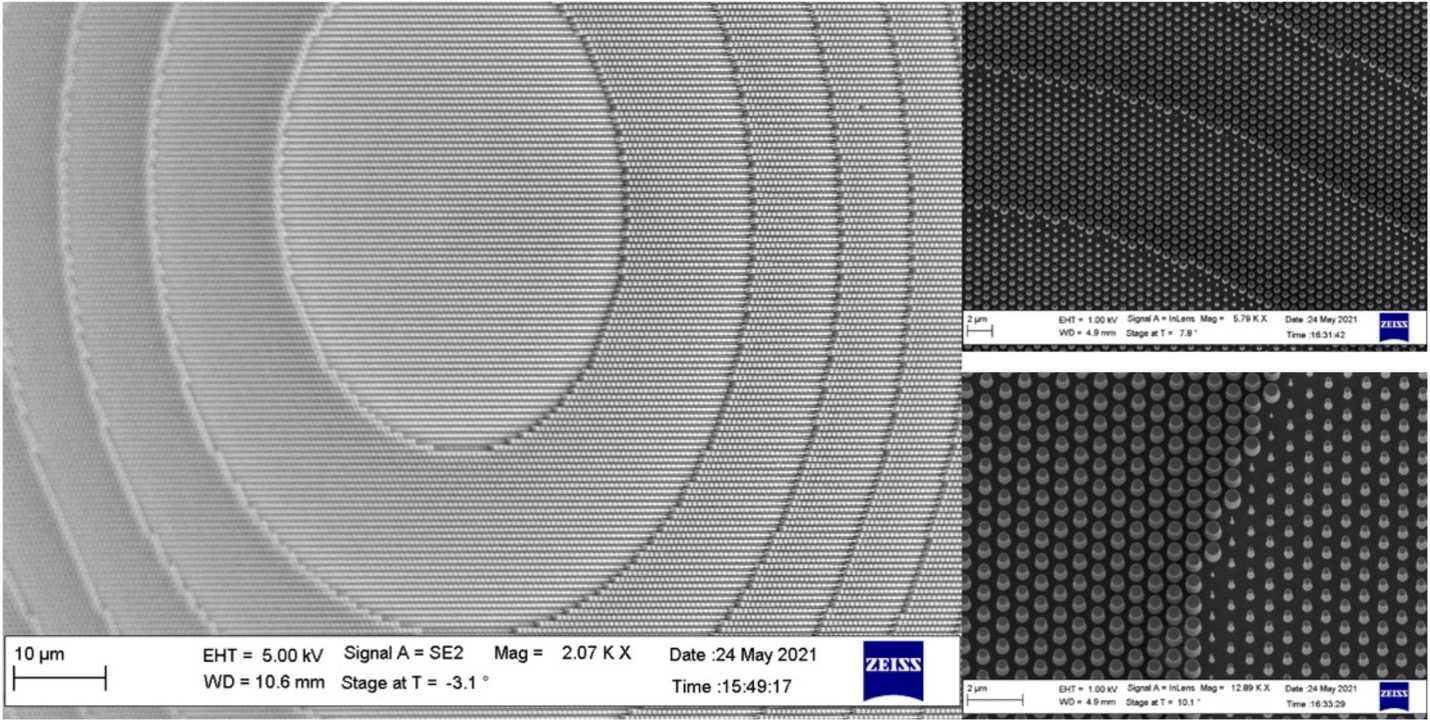Creating Meta-Lenses by Manipulation of Light
01 Feb 2023
University of Illinois Chicago Students Explore Meta-Optics at Army Research Laboratory in Adelphi, Maryland
Education Research and Training Collaborative, a DoD STEM-supported program at the University of Illinois Chicago, provides rigorous summer research opportunities for undergraduate students in STEM disciplines.

Photos By: Jason Sun, U.S. Army Research Laboratory, Adelphi, MD
The above image depicts the patterns created by scanning electron microscope images of the surface of a meta-lens. This pattern was produced by a beam of electrons programmed to etch the desired pattern onto a thin silicon film. These patterns are designed by computer simulation to make light behave in specific ways when it hits the meta-lens surface. Left image, about 2 millimeters across; Top right image, about 0.4 millimeters across; Bottom right image, about 0.2 millimeters across.
Meta-optics is a new technology that has received a great deal of attention recently due to the ability to manipulate light in a variety of ways, rather than simply focusing light to produce images. Harnessing the basic properties of light itself, it is possible to create "meta-lenses" that are superior to normal glass lenses in performance and allow highly customizable optical components for specific applications. This technology has the potential to revolutionize the development of devices used by soldiers in the field that process continuous streams of information on position, distance to objects, and speed of movement.
The performance of lenses and other imaging components that are currently used in such devices is limited by a variety of factors, including the availability and durability of materials, and the difficulty of manufacturing complicated shapes to exact measurements. In addition, efforts to miniaturize devices that will ultimately be used by soldiers in the field are hampered by the physical space required for accommodating electronic components. At the same time, these devices must contain lenses that allow for the rapid focusing of images. One of the key goals of research in this area at the interface of science and engineering is to develop new optical technologies that are not subject to these limitations.
Working with Dr. Weimin Zhou and Dr. Sang-Yeon Cho at the Army Research Laboratory (ARL) in Adelphi, MD, University of Illinois Chicago (UIC) senior Alejandro Perez spent the summer of 2022 developing methods for producing meta-lenses and analyzing their performance. Alejandro is a participant in the Educational Research and Training Collaborative, a DoD-STEM funded program at UIC whose goal is to provide a rigorous, intensive introduction to the practice of research for undergraduate students in STEM disciplines. As a complement to his research at UIC, Alejandro undertook a summer project at Adelphi ARL to develop additional expertise in his field.
Conventional glass lenses are very effective at focusing light, but images that are created by a glass lens are often out of focus in some areas of the image due to light passing through different thicknesses of glass. The goal of a meta-lens is to reach the limit of a very thin lens, where the complete image is in sharp focus. Computer simulations of the ideal behavior of light provide a pattern that can be produced by a specially designed surface. Working back from this desired behavior, the meta-lens can then be designed to replicate the behavior of the thin flat lens.
The meta-lens itself is designed and fabricated to focus and create images from infrared light, which is invisible to the human eye. This is the same principle that makes night vision goggles effective in producing images when very little natural light is available. For a meta-lens, a film of silicon 940 nm thick (about 1/100,000 inch) is deposited on a thin quartz plate. An electron beam then modifies the surface according to a pattern (Figure 1) that has been pre-determined by calculation to give the desired behavior of the lens. With this technology, a meta-lens can be designed to control the behavior of light in very complicated ways.
Meta-lenses produced in this way have demonstrated the possibility for use in a wide range of applications, including chip-scale optic receivers, infrared light sensors, and smart glasses, all geared toward improvement of the quality of information received by personnel in the field.